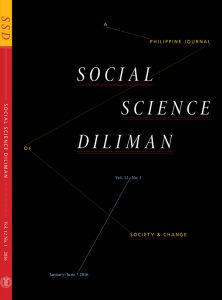 The latest issue of “Social Science Diliman,” (SSD/Vol. 12, No. 1) is now available online. Edited by Dr. Ma. Mercedes G. Planta, issue has three articles, historical notes, two book reviews and two essays of tribute to the Faculty Center.
The latest issue of “Social Science Diliman,” (SSD/Vol. 12, No. 1) is now available online. Edited by Dr. Ma. Mercedes G. Planta, issue has three articles, historical notes, two book reviews and two essays of tribute to the Faculty Center.
In her notes, Planta says SSD has brought together “works on education, language and history.” She explains that even if the issue appears to be broadly themed, the works are actually held together by the “commitment to pursue new paradigms and new ways of looking at both old and new issues while challenging or refining the current mode of analysis, so that SSD becomes ‘a place’ not only to make research available but also ‘a place; to reflect upon research.”
The three articles are “Inclusive Education in the Philippines: Through the Eyes of Teachers, Administrators, and Parents of Children with Special Needs” by Michael Arthus G. Muega; “Sariling atin: Ang nagsasariling komunidad na pangkomunikasyon sa disiplinang Araling Pilipino” by Ramon Guillermo; and “Lagda ni Andres Bonifacio: Paghamon sa tadhana, himagsikan, at pagtupad sa kapalaran ng sambayanang Pilipino” by Epifanio San Juan Jr.
Muega’s article is about the knowledge in and involvement of schoolteachers, school administrators, and parents of children with special needs in implementing inclusive education. Inclusive education lets children with and without disabilities learn together in a general education setting.
Guillermo’s piece discusses the possibility of a Philippine Studies or Araling Pilipino community. Planta writes that Guillermo “decenters ethnicity, nationality and provenance as qualifications for inclusion in the community of scholars in Philippine Studies. What matters, he says, is the participation of scholars in dialogue with each other as they engage in the production of knowledge on Philippine Studies. This inclusive community constitutes what Guillermo calls autonomous Philippine Studies.”
Meanwhile, San Juan’s work describes the Philippine society’s contemporary realities particularly its socio-economic imbalances.
“The roots of these realities,” Planta said, “are traced back to the feudal political economy in the 19th century, particularly with the opening of the Philippines to world commerce at the end of the Manila Galleon.”
In addition to the three articles, SSD features for the first time a section on historical notes. Featured for the issue is Ramon Guillermo’s “Siempre he encontrado en dicho camarada un verdadero espiritu revolucionario: Tala hinggil sa ilang bagong tuklas na dokumento sa Arkibo ng COMINTERN hinggil sa mga mandirigmang Pilipino sa Espanya na kaanib sa Brigada Internacional (1936-1939).” The author shares newly found documents from the declassified archives of the Communist International (Comintern) on the Filipino combatants who fought with the Republicans during the Spanish Civil War. This also gives new information on the history of communism in the Philippines.
The issue also has reflective essays from Gemino H. Abad and Ricardo T. Jose that pay tribute to the Faculty Center and reviews for the books “Representing Children in Chinese and U.S. Children’s Literature,” edited by Claudia Nelson and Rebecca Morris and “Hidden Lives, Concealed Narratives: A History of Leprosy in the Philippines” edited by Maria Serena I. Diokno.
This is Planta’s maiden issue as SSD editor. The journal’s international advisory board also welcomes JC Galliard, Hal Hill and Vineeta Sinha.
Planta describes the journal’s cover design as breaking free “from the unified template of the Diliman journals.” Designed by Karl Castro, the new SSD look aims to be distinct with a balance of boldness and sustainability “to reflect the dynamism of SSD—a journal rooted in the present but well aware of and engaged with the larger historical past,” Planta writes. The new look comes in black, the color of gravitas.
